| Lockwood
Custom Optics at the Winter Star Party 2024 Under southern skies with my new 12.5" f/2 dedicated nightvision telescope All images and text Copyright Mike Lockwood, 2024. May not be used without permission. |
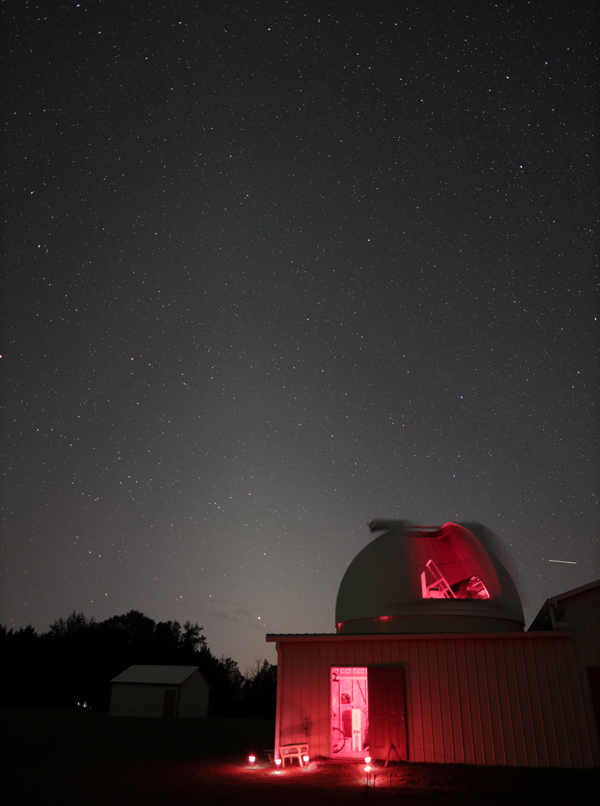 Escape from
Cloudonia Escape from
CloudoniaIt is an understatement to say that December 2023 through January 2024 was cloudy in the midwest. After an absolutely beautiful, warm November, which I suspected we would pay for later, a switch flipped and it was almost completely cloudy. As many of you might understand, it's tough to go without adequate sunshine and clear skies for an extended period. You get that sort-of-lethargic feeling, your brain doesn't work quite right, you may spend too much time on various internet astronomy sites, and you simply long for spring. Okay, maybe you don't get that syndrome, but I certainly do, and this year was bad. I was getting work done, but it was getting old and it was getting cold. However, it wasn't quite Boat Drinks bad, though. The lyrics to the song Boat Drinks, by Jimmy Buffett, a song about sitting in a bar in a cold climate watching a hockey game and trying to forget about said cold climate, go as follows: "This morning.... I shot six holes in my freezer, I think I've got cabin fever. Somebody sound the alarm". It wasn't that bad, but it was not a pleasant period and it was certainly past time for a break. Sadly we lost Jimmy in 2023, but we got to enjoy a new album, some of his best work in a while, just after he passed. His version of the Crosby, Stills, and Nash song Southern Cross is often featured before various events at WSP. For me the Florida Keys, which he helped popularize, bring to mind his life and music. I managed to be packed and ready to go with time to spare on Friday. I even had my last-minute machining done in the form of a bushing that centered my Canon G15 lens on the ocular of a PVS-14 or Mod3c (different nightvision models), allowing me to take better photos of the sights I hoped to see low over the southern ocean under warm, clear skies. I joined friends for beer and tacos at Riggs Beer Company as usual on Friday evening. Then I went home and managed to fall asleep at a reasonable hour and get up a bit earlier than expected to get on the road to Alabama, my first stop. I was more than ready to go on that Saturday morning. It was foggy, and I had been concerned about visibility when I finally pointed the car south. Thankfully I could see far enough ahead that I didn't have to slow down, and it was gone when I hit rain an hour or so into the journey. My deep hatred of I-24 reaffirmed I had my doubts about this trip as I attempted to navigate I-24 eastbound between Clarksville and Nashville, TN, in the rain. A semi changing lanes abruptly nearly ran me into another vehicle. Oh, I forgot to mention that I was dodging potholes the size of a kitchen sink because the road was coming apart. They even had those electric signs along the side of the road warning of holes in the road. Thanks for that! As we passed one bad area, I noted several vehicles on the side of the road in both directions, no doubt disabled with flat tires or worse thanks to the unacceptable condition of the interstate, and with some aid already there helping them out in the rain. This stretch of I-24 is my least favorite on my way to Florida due to hills, lots of traffic, and trucks passing trucks backing up traffic. They managed to make it even worse! I felt bad for those with low-profile tires that they think look good, but they're really much more susceptible to punctures and even damaging or destroying rims on bad potholes. I did not have those tires, thankfully, but I was using all of my limited video game skills to avoid the areas where the pavement was crumbling so the alignment on my Subaru would not be wrecked, or worse. 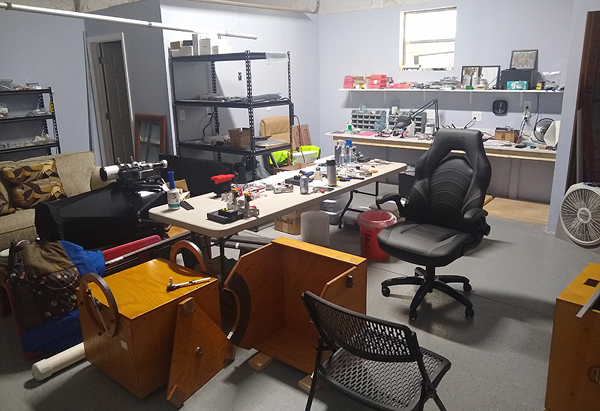 Thankfully
I made it to Nashville with my vehicle and most of my wits intact, but
I was not nearly as relaxed as I hoped I would be. Even better,
instead of continuing on said hellhole I-24, I was turning south to
Alabama and would completely avoid the other troublesome section of
I-24 between Nashville and Chattanooga. Thankfully
I made it to Nashville with my vehicle and most of my wits intact, but
I was not nearly as relaxed as I hoped I would be. Even better,
instead of continuing on said hellhole I-24, I was turning south to
Alabama and would completely avoid the other troublesome section of
I-24 between Nashville and Chattanooga.After passing through Nashville with no issues, traffic thinned out, the clouds began to break a bit, and it was actually mostly cloudy in Alabama with peeks of sun. That was nice. After a stop at a massive and surely colossally overlit Buc-ees gas station larger than some small towns in area and populations, I was back on the road refreshed and fairly close to my first destination. I arrived at John and Cindy's mid-afternoon, and we caught up and I delivered beer that they couldn't get near where they lived. (On the return trip, I would pick up some beer that I couldn't get. See how it works?) I spent some time there decompressing, enjoying the outdoors on walks and hikes, and watching a couple of playoff games before making the next push south to the Chiefland Astronomy Village. I arrived at Dana and Doris' place around dinner time on Tuesday. After a meal we relaxed and another resident of CAV that I had not seen for quite a while stopped by. We did a small beer tasting and caught up. The moon would come up fairly soon and skies were not completely clear, so we postponed observing until Wednesday night. On Wednesday, I walked just down the road to visit Bill Conrad, the new owner of Servocat, and got to see his shop with all sorts of parts organized and ready to make into new drive systems. It takes more parts than you think to build them, and he was working. He graciously took time out of his schedule to talk for a bit. We had a very early dinner at a nice little restaurant on the Suwannee River (yes, the one from the song, and not too far from where it meets the Gulf of Mexico) called Treasure Camp. Here's the view from the restaurant of the river. It was cool, so the windows were closed, and we were just about the only ones in the place for an early dinner. The food was excellent, and we had time before it would be getting dark to prepare a bit and rest. It's always best to eat a bit early and then have time to digest before observing. 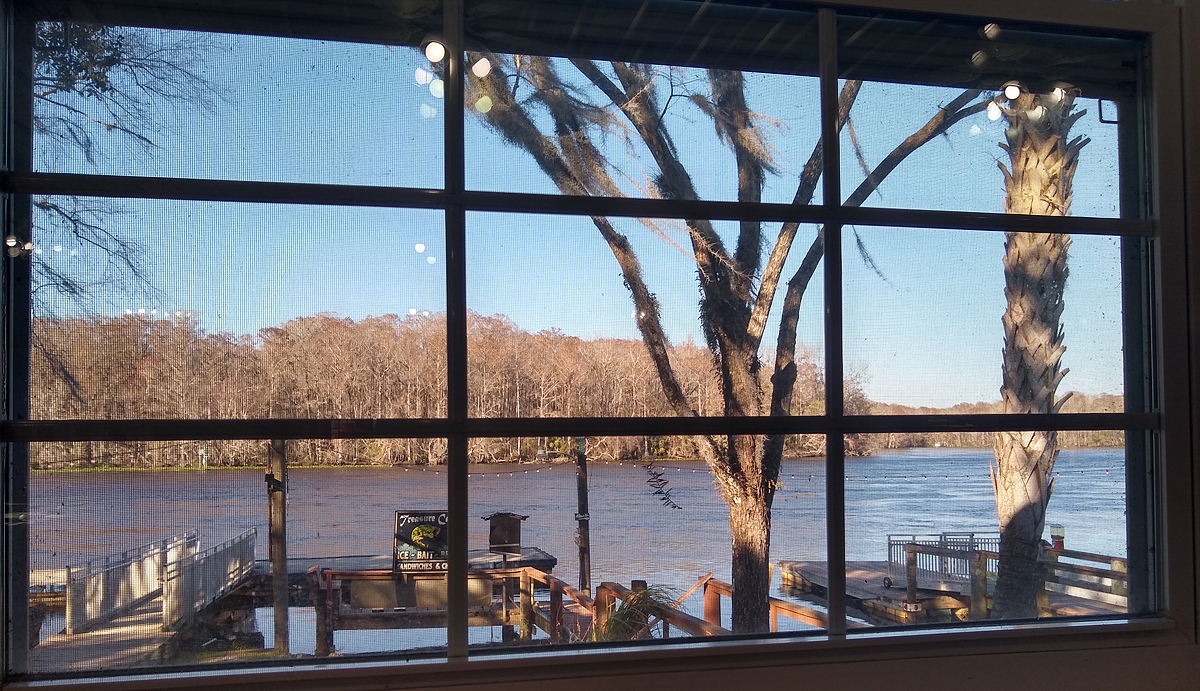 We loaded up a filter slide for the 28" telescope, and I set up my camera as it got dark. It seems that clear skies had not been frequent at Chiefland this winter either, so it was nice to have a few hours of good observing before the moon came up. I always love seeing the Zodiacal light at Chiefland, of course this is what's in the image at the beginning of this article. Note the large telescope in the dome, which I caught rotating during the longer exposure, revealing more of the interior. The dome and telescope are on the second floor, giving a better view of the southern horizon, and sometimes getting above the layer of ground fog that can end observing for those without proper elevation. After hitting some familiar targets, we started progressing through some of Vic Menard's list of favorite objects. The sky was not as dark as it could be, nor as steady, but it was nice to do some visual observing. We decided to pack it in a bit before the moon came up due to the sky conditions and the cold. Despite being in Florida, it had dropped into the 40s with a bit of a breeze. I did not get out the 12.5" NVT because it would have involved unpacking half the car, and I was not ready to do that until it was for the week at the WSP site. We did, however, use my PVS-14 and a 41mm Panoptic to view the Horsehead, Flame, M42, the Seagull, and another object or two. We were quite satisfied and went in to warm up. 12.5" NVT Upgrades/Modifications/Improvements and useful additions Before I get much farther into the trip, I now realize that I have completely skipped the modifications and additions that I have done/made on/to the 12.5" f/2 NVT (NightVision Telescope). After Okie-Tex, I needed to add baffling, add encoders, add a computer/DSC, add a battery and wiring system, add a holder for a tablet or star chart, and I wanted to replace the side bearings with something larger and thinner. I also decided to build a rocker box and tripod that could break down for travel, and that would place the telescope at a comfortable level for seated observing over the whole sky. With such a short tube, the difference between horizon and zenith NVD ocular height was only about 9.5" (!), so this was fairly simple. After the other steps were finished, I set up my observing chair and used a hydraulic lift cart to raise and lower the telescope to what I felt was a good height, then I made the tripod. I have not seen a tripod built in this way that I can recall, but it's incredibly sturdy and does not budge if I stand on it. 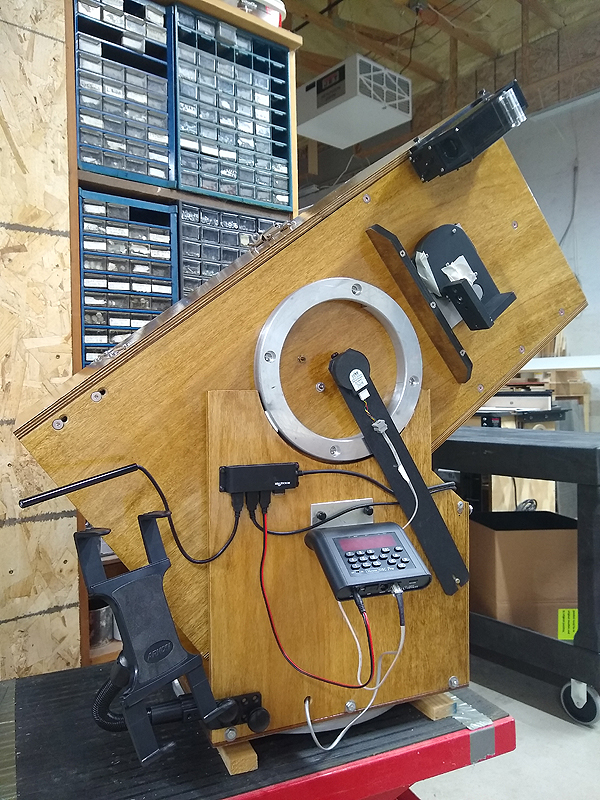 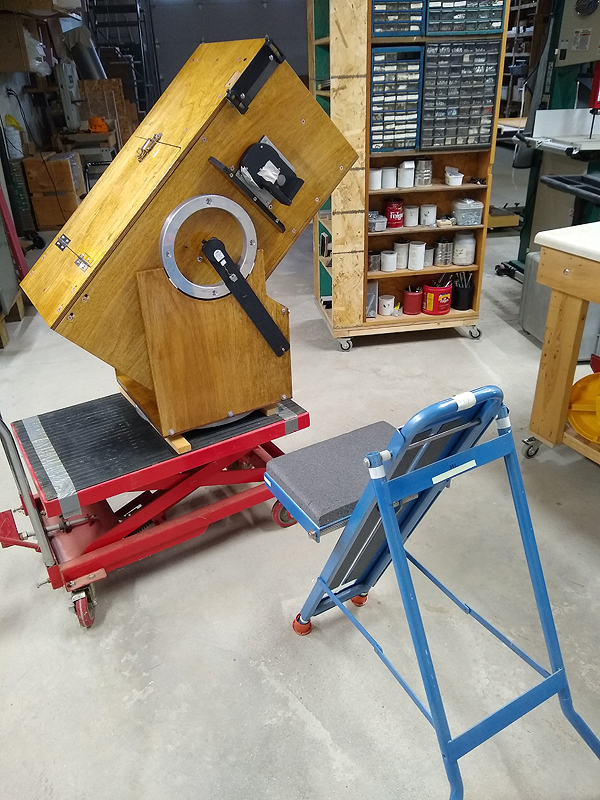 I decided to use some aluminum rings that I already had for the side bearings. They had been waterjet cut out of a disk of aluminum, so they were different sizes and one had previously been inside the other. Instead of adding handles to the top of the tube, I cut a recess/fingerhold in the inside top of the bearing to allow my fingers to curl around them so I could pick up the telescope by the bearings. It works very well. Here are a couple of photos from that machining. Keep in mind that the top of the bearing in the photo is the side that will be against the telescope tube. 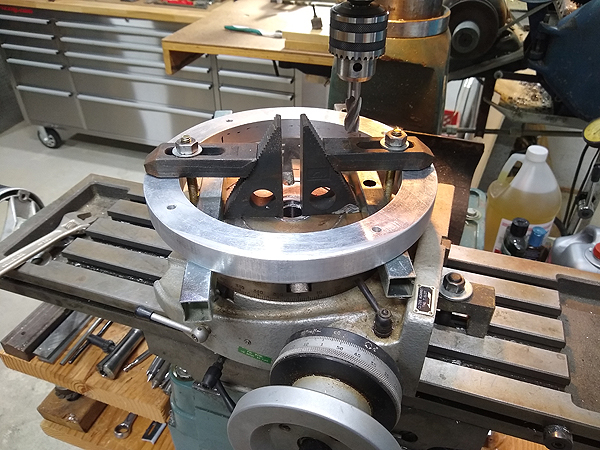 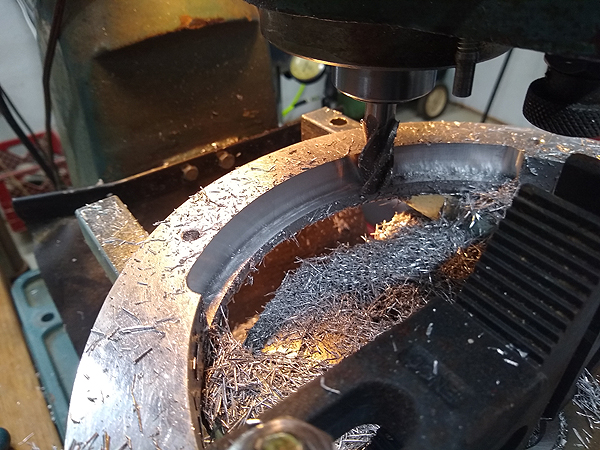 The machining was straightforward, but getting them clamped was not. I managed to finish the job after making a mess, and the built-in handles worked better than I expected. Back to the trip..... after catching up on email in the morning, on Thursday afternoon I headed southeast to pick up my guest for WSP, my friend Kara. She flew into Orlando, and after only a short wait at one of the convenient parking lots with restaurants and fuel at the airport, I picked her up in the midst of a sea of chaos with four lanes of crazy people trying to pick up their friends and relatives. I have never seen such a chaotic scene in the loading zone at an airport, and I was grateful to escape with my car intact. We took advantage of the relatively warm weather to grill dinner and enjoy not being in winter weather. 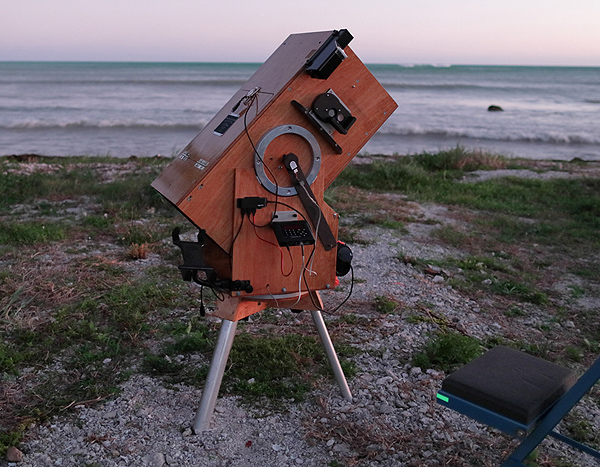 The
next day I did two waterski lessons on a cool but calm day. I
managed to run a couple of slalom course passes after not skiing since
October. I could not have expected more, and I think Kara was
good luck. She even got some good photos, which I really
appreciated, and a video or two. The
next day I did two waterski lessons on a cool but calm day. I
managed to run a couple of slalom course passes after not skiing since
October. I could not have expected more, and I think Kara was
good luck. She even got some good photos, which I really
appreciated, and a video or two.We continued on the short trip to my uncle's place, stopping at a couple of stores I knew in search of some good beer and a rum that John and Cindy had requested, which we found. We spent Friday and Saturday relaxing and getting acclimated to the warmer temperatures. We had a nice dinner on the intercoastal, and I managed to get a run in for a bit of a workout in the warm sunshine. Off to the Keys On Sunday morning we left under low clouds, knowing we would hit rain to the south. Our timing was nearly perfect. We had rain north of Miami, and then slipped through a bit of a gap in the storms and out into an area of clouds only. For the first time possibly ever, we did not encounter a traffic backup in the Keys on the way to WSP. I think Kara is good luck. The sun was starting to break through after we had a nice early dinner at Keys Fisheries and walked a little bit on the old Seven-Mile Bridge, which was now open and nicely restored. Then it was time to get to the WSP site and get situated and ready for observing. After visiting a bit with Neal and others, we set up camp and the telescope. It was great to have help with this, and soon we were ready for a clear but very humid night. I didn't have much dew fighting capability, so I crossed my fingers that the closed tube would protect the optics from dew. I kept the NVD (nightvision device) in my pocket when not in use, and put the cover on the telescope when we took breaks. This worked, and I did not dew up that very wet Sunday night. Every ten minutes or so I would wipe down the top of the telescope with a towel to prevent it from getting inside through the access hatch. The sky was clear and dark, but a little bit hazy. Transparency was down, but we didn't care, the southern sky was on display as we observed about thirty feet from the ocean. It would not be clear to the horizon on this night, but the haze layer only came up a few degrees and didn't interfere with most observations. In fact, the clouds in the distance allowed for some dramatic images on later nights. In my 2023 article I mentioned that it was likely my 12.5" f/2 nightvision telescope would be with me on this trip, so it was nice to make that prediction come true. See the image above right for the observing setup, very close to the breaking waves. This is what WSP is all about - a dark, unobstructed view of the southern sky with a sea breeze blowing. The sound of palm fronds in the wind used to be more prevalent, but many of those have been taken out by hurricanes since I started attending. It was great to have such a wide-field, conveniently-sized, photon-amplifying machine at my disposal in this wonderful environment, I had great company, and I wasn't freezing my ass off! Life is good. Let's get to the observing. See the telescope and myself below, the red lights are to mark the location of the telescope and tripod legs, and they are not bright enough to affect dark adaptation. However, they do saturate the camera during modest length exposures. 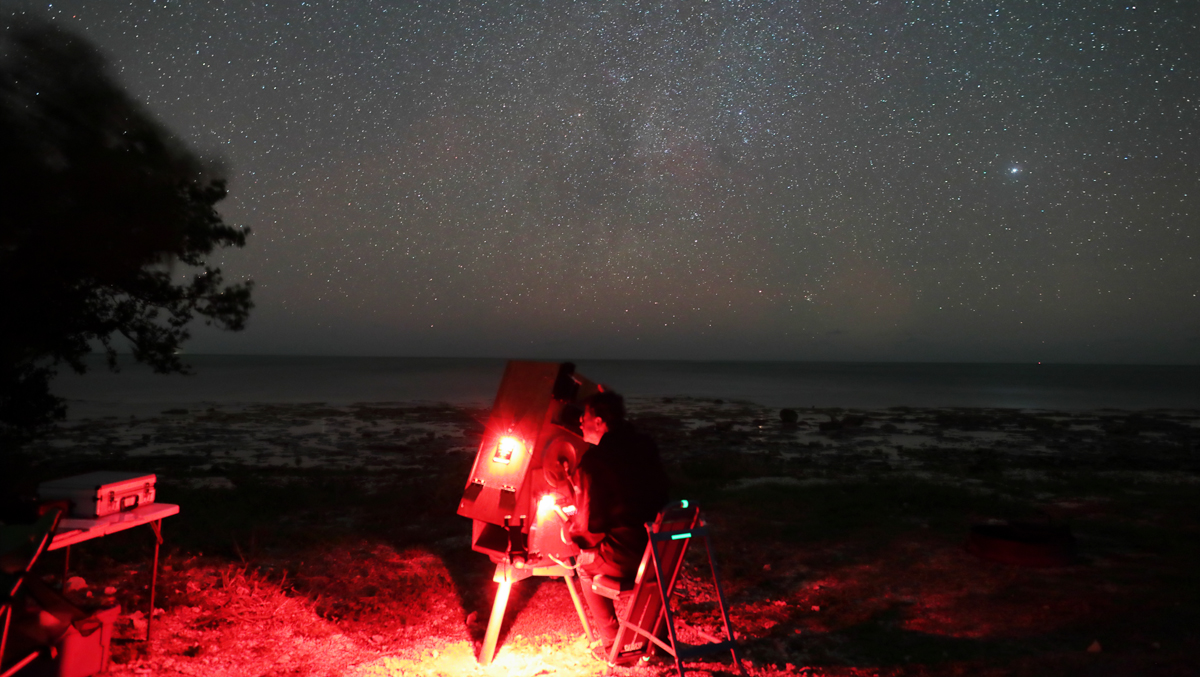 I did change out a filter for this trip, after seeing recommendations of IR-blocking filters to darken the sky background under some conditions. Here is the filter wheel filter list, in order: Astronomik UV+IR-Blocker L-1 (360-730nm passband), 490nm longpass Baader (full spectrum for this scope), Celestron UHC, 6nm Baader high-speed F/2 H-alpha, and 3.5nm Baader high-speed F/2 H-alpha. I grouped the Baaders together to minimize refocusing, because the Astronomik is a different thickness. I removed the Astronomik 12nm H-alpha filter for this trip, because it is best at really, really dark sites and added in the IR-blocker in its place. For reference, the NVT has a field of view of about 1.6º, so that's what you see visually and also in the photos below. Prepare for photon amplification So, here we go. On this first night there was no plan, it was freeform observing, and various people stopped by. We observed the usual H-alpha objects for the benefit of those stopping by - M42, the Flame and Horsehead nebulae, Barnard's Loop, the Rosette and Cone nebulae, Sh2-280, 282, and 240, the Jellyfish nebula (IC 443 and 444), Lower's Nebula, NGC 2174/Sh2-252 (Monkey Head nebula), IC 443 and Sh2-247 at the feet of Gemini, IC 405 (the Flaming Star nebula) IC 410 with NGC 1893 (near the Flaming Star), NGC 1931 and IC 417, Sh2-231, 232, 233, 234 and 235 in central Auriga, and the California nebula. The edges of Sh2-264 (centered on Lambda Orionis at the top of Orion) were visible, as was some variation in brightness within it, but it was difficult. We observed the huge Seagull nebula complex (IC2177/Gum1/NGC 2335/Ced 90) covering about three fields in the NVT, as well as NGC 2467 in Puppis, we think NGC 2170, and Sh2-308, the Dolphin Head nebula, faintly glowing in a bit of H-alpha. 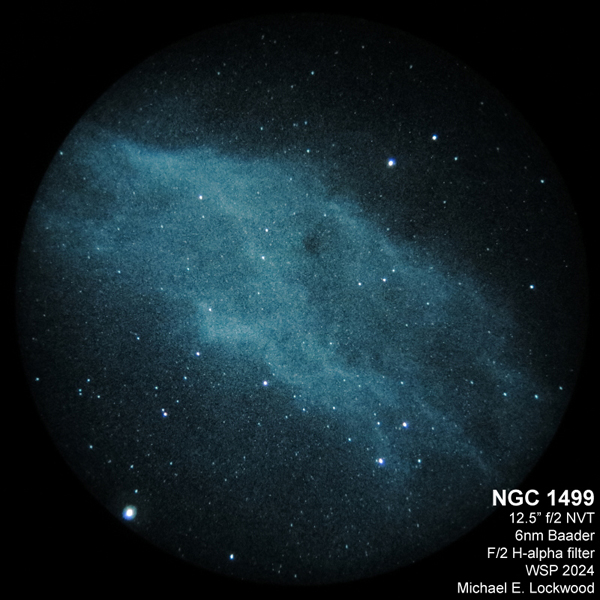 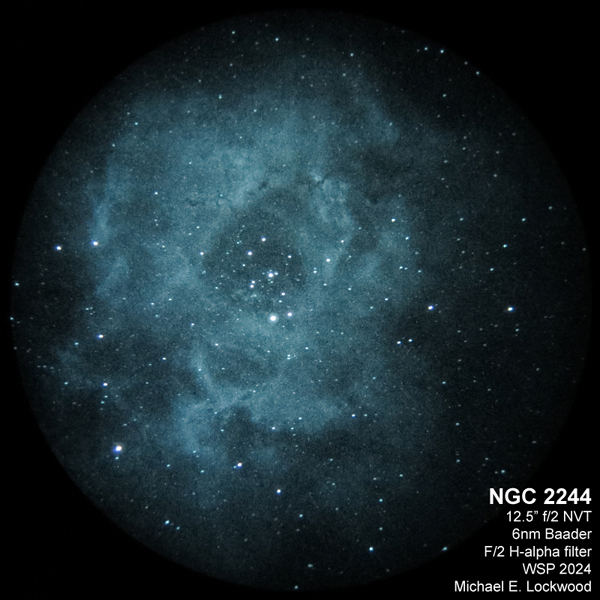 I also came across IC 2162 while scanning. I call it the Snowman nebula, and a snowman is the official mascot of WSP, so I declared it the official nebula of the Winter Star Party! 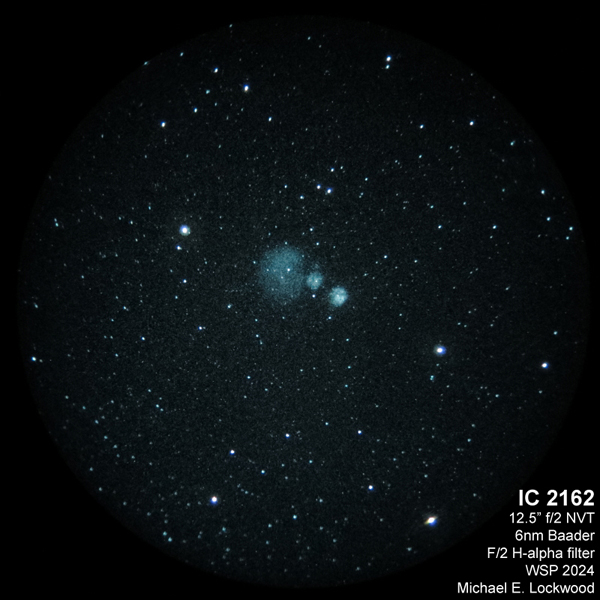 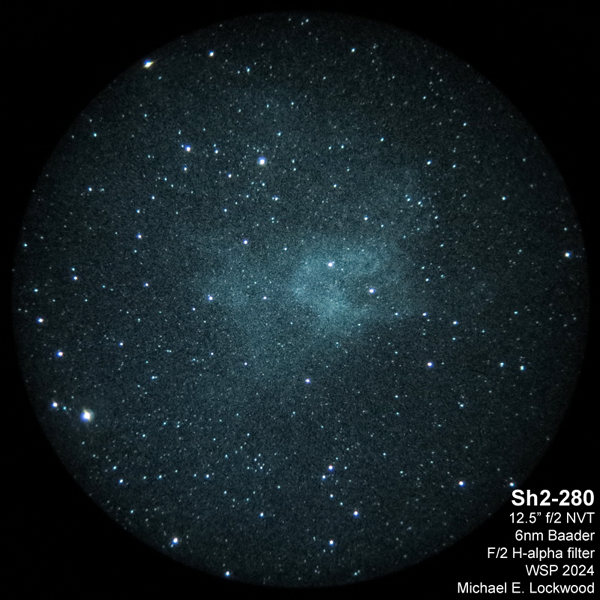 As Vela rose higher, I began scanning the massive area of the Vela Supernova Remnant (SNR), and we enjoyed the beautiful NGC 2626, Gum 15, Gum 17, Gum 23, Gum 25, and a plethora of beautiful arcs in the Vela SNR in the right triangle formed by Lambda, Gamma, and the star above. Words can't express all there is to see in this roughly ten by ten-degree area of the southern winter Milky Way, one just keeps coming across things. 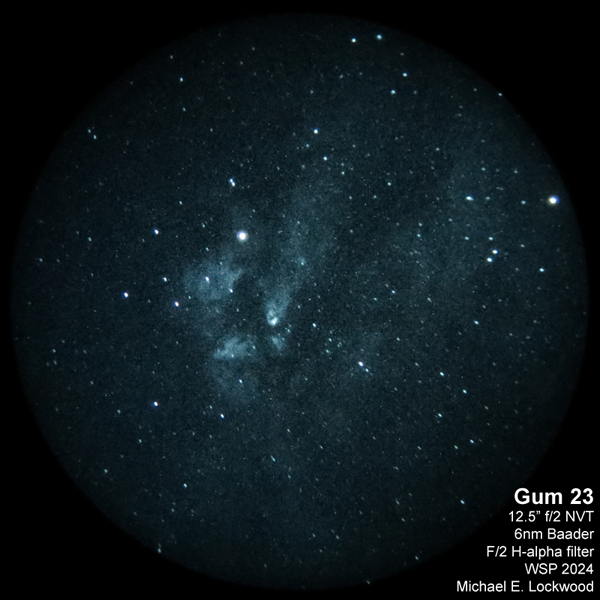 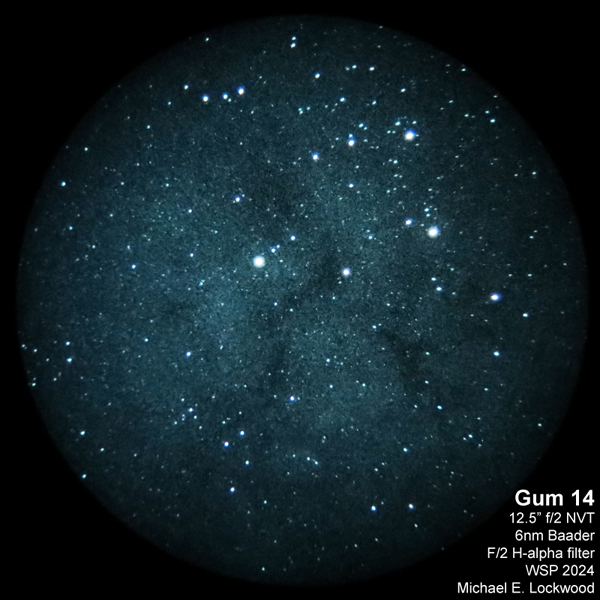 After all of that H-alpha observing and showing objects to people, I decided to just scan the entire Milky Way from horizon up through the top of Canis Major with the full band (Baader, filter 2) 490nm longpass and the IR blocker (Astronomik L-1, 725nm cutoff just to see what I came across. The IR blocker seemed to improve the views by darkening the sky. Can't wait to try a lazy scan on the summer Milky Way at Okie-Tex, the dark nebulae really jump out. 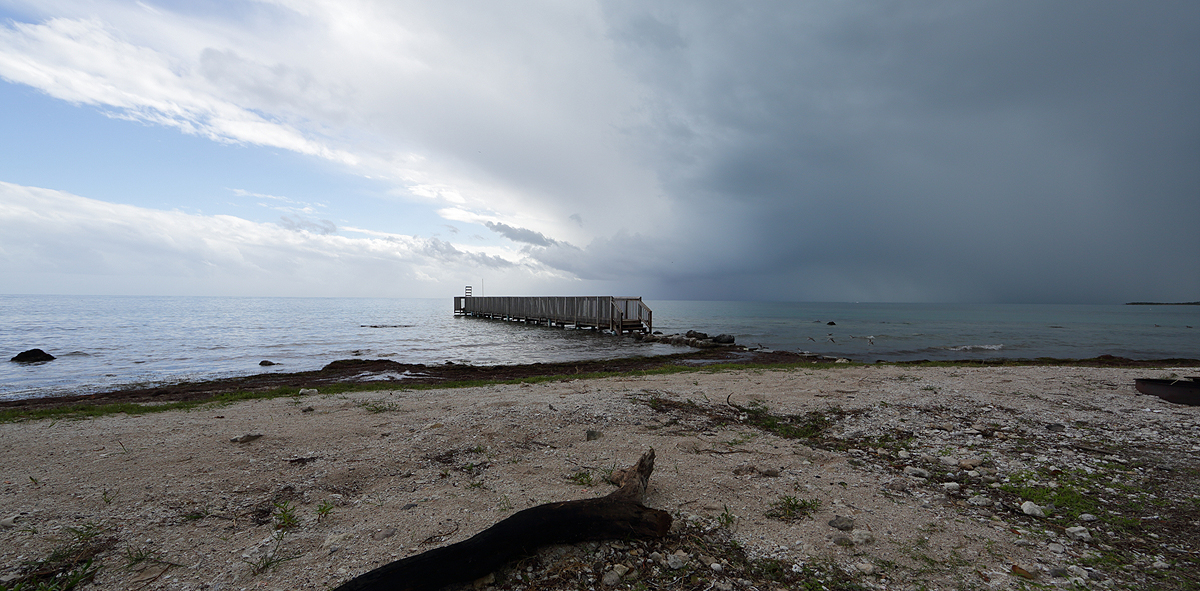 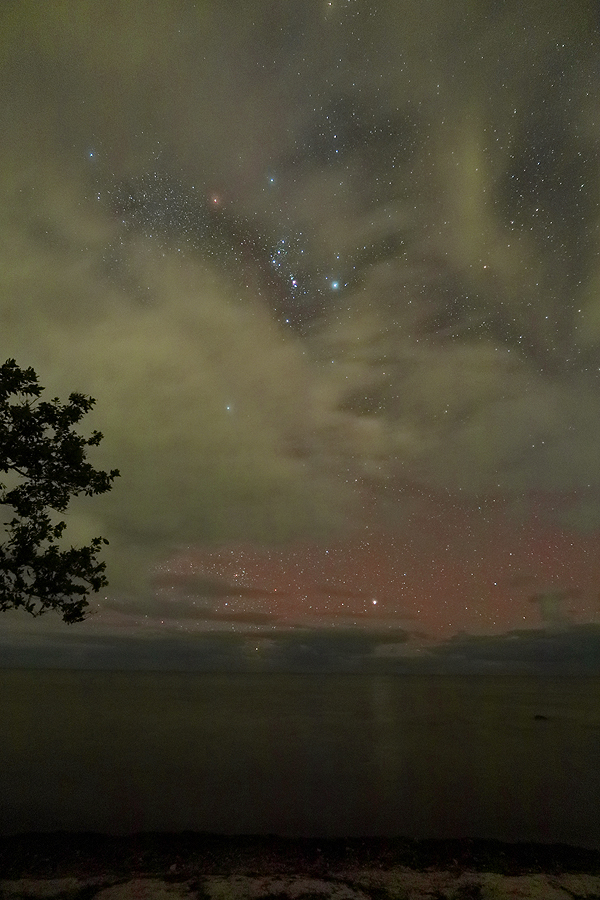 As it became clear that the
clouds to the south would not reveal more
of the objects very low on the horizon, we decided to call it a
night. I dried off the telescope one last time and covered it on
the porch of the tent, anticipating incoming rain and strong winds the
next day. While it might have been fine on the short tripod, I
did not want to risk it. As it became clear that the
clouds to the south would not reveal more
of the objects very low on the horizon, we decided to call it a
night. I dried off the telescope one last time and covered it on
the porch of the tent, anticipating incoming rain and strong winds the
next day. While it might have been fine on the short tripod, I
did not want to risk it.A rainy Monday, a superb Tuesday Monday, Feb 5th dawned rainy and windy in the morning as expected. There was one good squall with small hail that went through early in the morning, and I managed to sleep through some of it. By the time late morning came, it had become sunny with a few passing showers. After getting organized and reviewing some of our previous night's observations and making notes, it was time to head over to Big Pine Key to the No-Name Pub for an early dinner with Charlie Warren. Kara and I had the Caribbean Chicken pizza, which was delicious but they had gone very heavy on the cheese, and we removed a bit of it. Their dark amber beer was quite good. We returned to Camp Sawyer with some leftovers and time to prepare for some limited observing. Monday night was mostly clear at the beginning, but we knew it was going to cloud up, so we wandered the field. We found Dean attempting to polar align one of his refractors through the large microwave tower that dominates the north side of the island that the two camps occupy. Of course he had set up exactly where one of the steel beams occults Polaris in the evening! Never fails, and this qualifies as a first world problem. We wandered down the former road near the old men's showers where multiple people had set up, making it tricky to walk through, but they had good views of the horizon. The north side of the other drive where we had set up in the past was muddy and a bit wet. We saw Harry and Steve set up in that area, and as I recall we sat down and talked for a bit to catch up. We came back to the tent and put our chairs in the wind shadow of our tent and shared some beer and some good rum, then we crashed and slept as much as possible despite the slapping of the tent canvas and the shaking of the structure by the gusty NW winds. It was really strong and gusty, and the temperature had dropped quite a bit. I'd characterize it as cool, something you don't often experience in the Florida Keys. Tuesday, Feb. 6th, dawned sunny with ~50% cloud coverage in the morning, and it was very windy. We had a snack and wrote an observing report from the night before. Our temporary roommate, Dr. Mario Motta (here is a link to his excellent light pollution web site), arrived and settled in. He was speaking later that day about objects in the southern sky and his 32" telescope, located on top of part of his house. It was great to get to talk with him about various topics, and to share some views through the 12.5" NVT of objects he probably never expected to see visually. After enjoying the view from the tent porch a bit, Kara and I headed into Marathon to the Florida Keys Steak and Lobster for the early bird special, which was delicious. We had a sushi roll for an appetizer, delicious entrees, there was good bread on the table, and then we knew we were stuffed. We took our Key Lime Pie to go for a late night snack and energy boost. Tuesday night was windy with some strong gusts, but dry and completely clear all night. This is not common, and later on I put this night in the top ten percent of nights at WSP due to the very transparent skies and despite the gusty winds. As I was setting up, the foam front cover for the telescope blew off and ended up in the ocean. Fortunately it drifted into an area where the wind was less strong, and it came in closer to shore so I was able to wade into about 18" of water on top of the unpleasantly sharp rocks and grab it. After drying out, it was time to observe. SQM readings were around 21.3-21.4. We began the evening with my 12.5" NVT, showing various people the showcase objects. Showcase objects are M42, Horsehead, Flame (in the same view) along with connecting nebulosity, Barnard's Loop, the Seagull (all parts of it in different fields, it's huge), Thor's Helmet (not that good in NV due to lots of OIII), the Monkey Head - NGC 2174, Sh2-247 nearby, Lower's Nebula (Sh2-261), the Jellyfish - IC443 and 444, IC 2162 (the Snowman!) the Crab nebula with H-alpha and the UHC filter, the Flaming Star and surrounding nebulas including NGC 1893/IC 410, NGC 1931, IC 417, Sh2-231 and 235, the California, Rosette and Cone Nebulas, and others nearby (IC 446 an IC 2169 I think). We also observed many of the objects in the Vela SNR (more later). NGC 2467 in northern Puppis was pretty and interesting and I took a photo. I'm including photos here in groups that are pretty much in the same area of the sky. It took quite a while to identify, verify, and label images and then process and resize them, but the work was worth it, and it helps you understand our experiences in this great location and see a bit of what we saw in real time with nightvision and filters. Note that the views to the eye were a bit better than the images. There was more detail and more subtle nebulosity. I had to hand-hold the camera with the help of the bushing/guide that I machined, but the wind was gusting and the little Canon G15 was doing its own focusing as best it could and I had no control there. I am on the lookout for a better way to acquire and stack images like cell phones do internally. 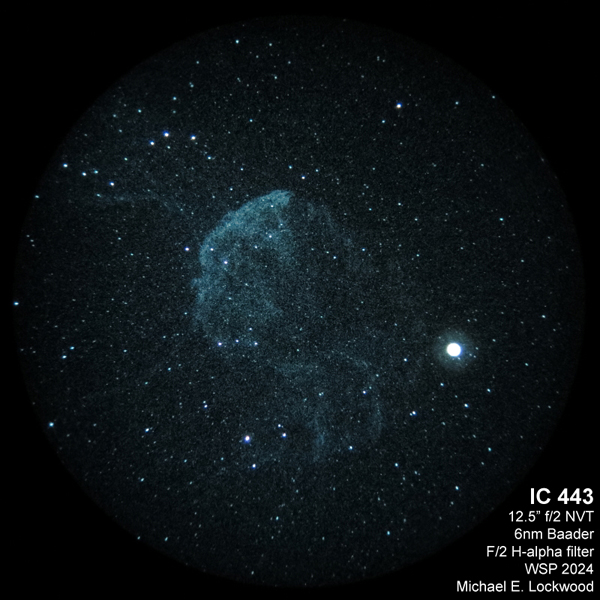 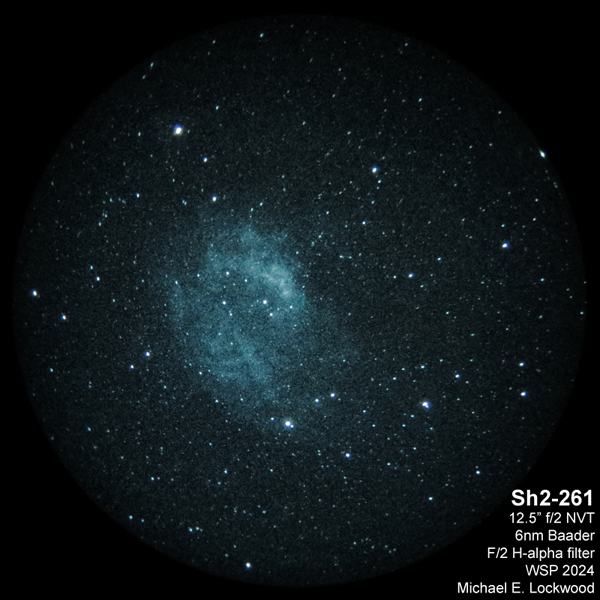 A really fun observation was made on a whim - I decided to try to look at Simeis 147/Sh2-240 near Elnath (Beta Aurigae). To my astonishment, it showed up as some clearly visible filaments with the 6nm H-alpha filter! Charlie Warren and others were very impressed that we could even see it, as was I. I'll have to explore it more at home when I have some transparent skies and it is nearly overhead. 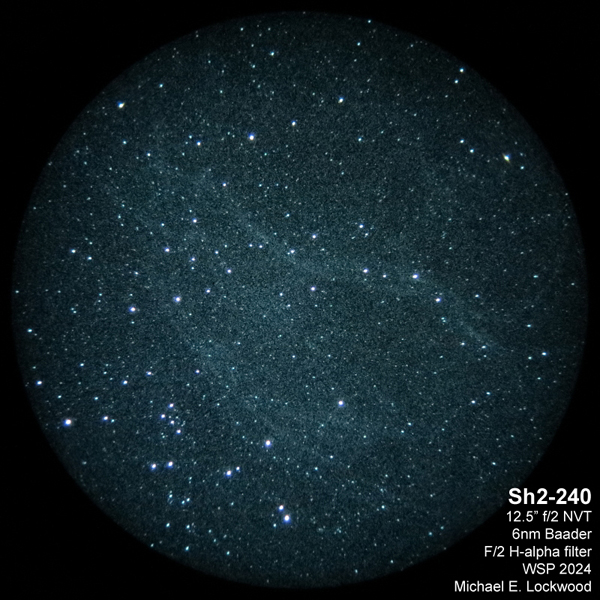 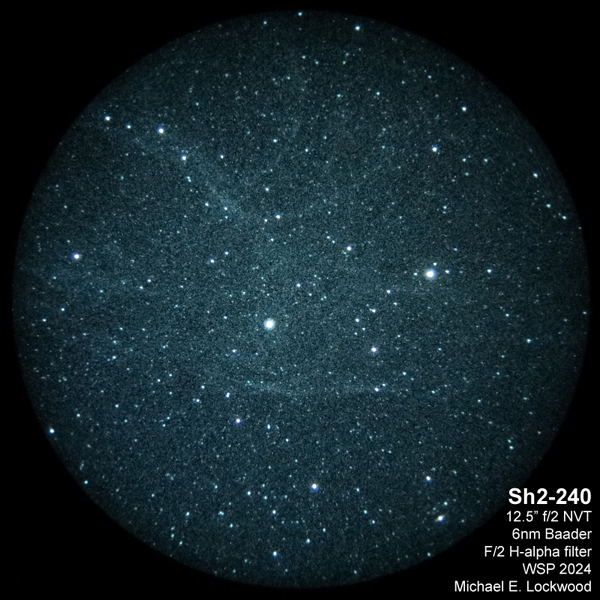 The Vela SNR was a highlight. We scanned the large area of nebulosity with the 1X nightvision unit and a 3.5nm filter. The whole ring and other arc/spike to the east (Sh2-312) showed up obviously, along with some other nebulosity in the lower part of Canis Major that we did not explore. Gum 23 and 25 were very nice and close together, and Gum 15 is nice on its own. Gum 17 filled the eyepiece, was just over from those. The arcs of nebulosity within the triangle on the north side of Vela (lambda and sigma) and the bottom star of Puppis contained most of it. I shot some 1X images of the Vela SNR with a 3.5nm filter, and it mostly fits in the area of the field that the H-alpha filter works in. Below left you can see most of the SNR, and several Gum objects are seen on the left side of it. At right, with the same field of view, compare Eta Carina for size. This part of the sky is something that every astronomer should see for themself. 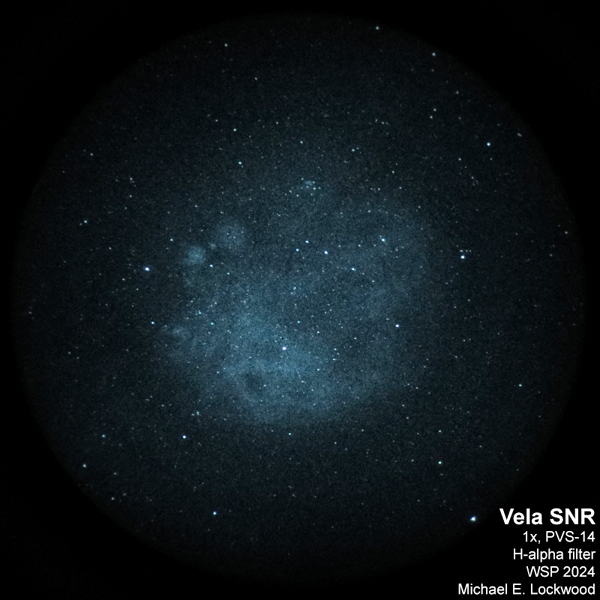 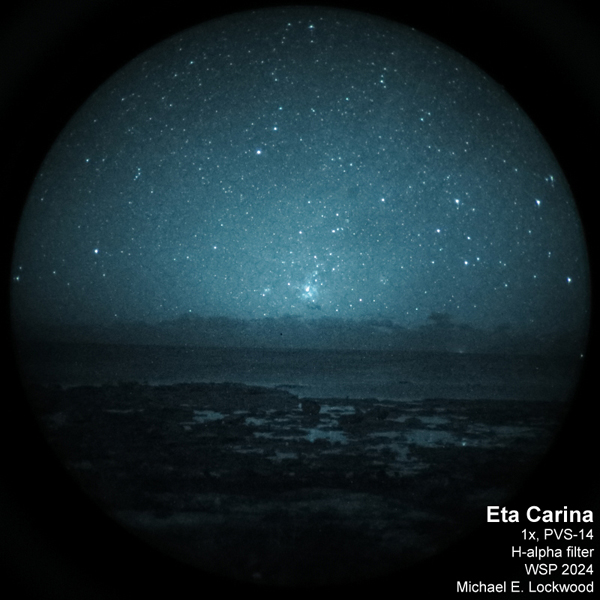 At some point, we took a break for an energy boost - our late-night key lime pie! That was the best snack ever, at least at WSP, though late-night brownies are a WSP tradition, and hopefully will be in years to come. Tim and Russ and other stopped by and scanned through the Heart and Soul. Knowing the sky, then they took their own self-guided tour back through some of the objects we had already seen. The telescope is very simple to use in this manner. Later on I began looking again with the 1X NV, and I saw a bright spot on the horizon, obscured by very distant cloud tops. It was Eta Carinae rising over the clouds! The view was incredible, and it resulted in my favorite photo of the star party below at right. I also shot some video. What a dramatic sight! 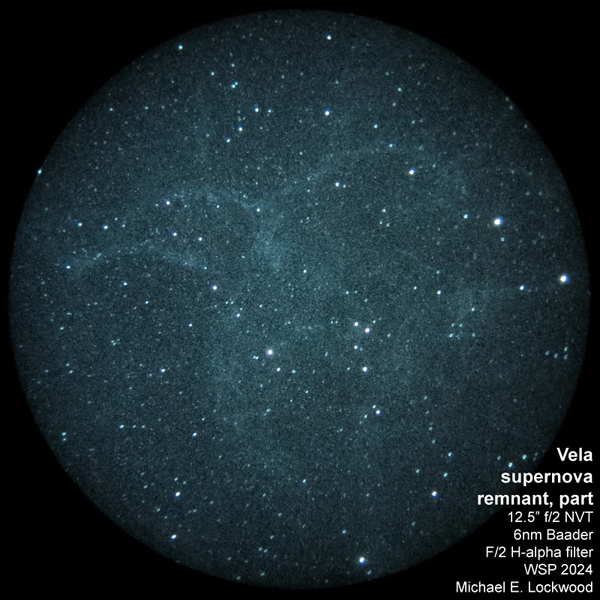 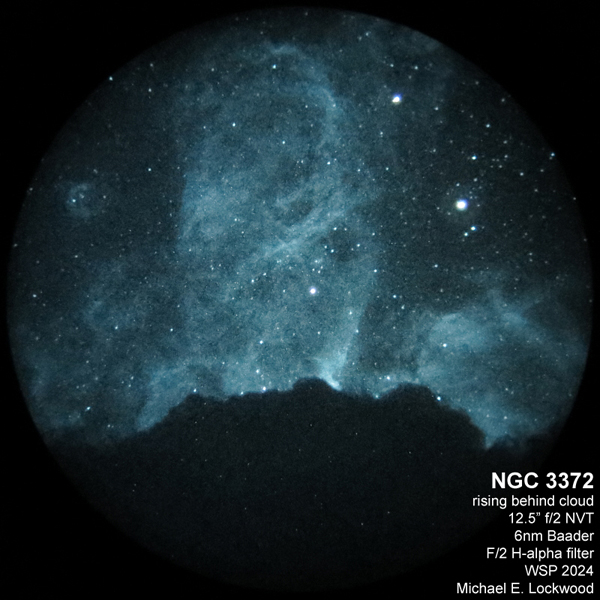 Observing the Eta Carina area - from NW to SE we see that NGC 3199 starts the chain of nebulae, then NGC 3247, NGC 3293, NGC 3324, and NGC 3532. After marveling at the nebula after it was high enough to view fully, we also saw some unknown nebulae a bit southeast of Eta Carina. 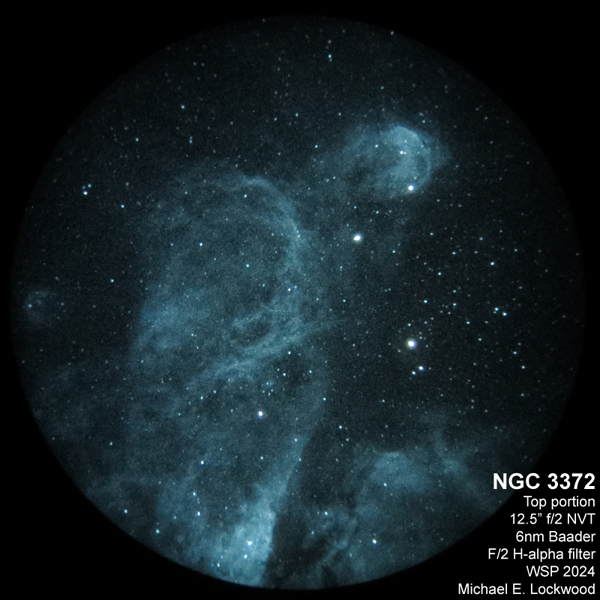 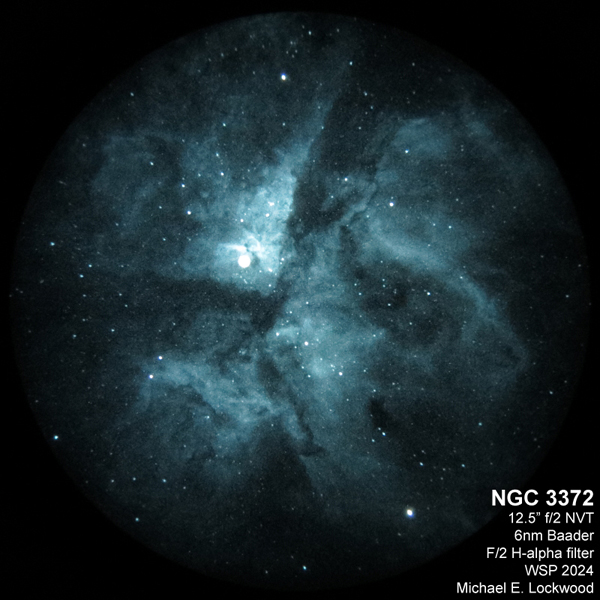 The Antennae galaxies (NGC 4038, 4039), showed very nice detail with both the wideband filter and the IR blocker. I was surprised how conspicuous their shapes were despite appearing very tiny in the NV ocular. The Sombrero galaxy (M104) showed an excellent dark lane. Omega Centauri was OK, but it is more impressive at higher power visually. NGC 5128, Centaurus A, showed its dark lanes, but not much galaxy past it. We finally hit the shower around 3:30am, and went to sleep at 4am, getting up around 10am after some well-earned, good quality sleep. Mid-Week Wednesday dawned clear and cool, with less of a breeze. We sat on the porch for a bit and then went through charts and notes and identified a large number of objects that I had photos of but had not identified due to the Nexus being off by a bit on azimuth and the wind making it difficult to write on paper. I'm not sure if the azimuth error is mechanical or something odd, or possibly due to the tripod shifting. More investigation at home will tell the tale. Dinner was at Boondocks further west of the WSP site, and we had fish sandwiches and lobster bisque and some fried cheese bites for an appetizer. It was pleasantly cool with a breeze blowing through the Tiki structure. We got back in plenty of time and took a break before uncovering the telescope. Some small clouds drifted through early in the evening, and then we saw a clear sky but with less transparency than the night before. After showing some of the showpiece objects to various passers-by, things quieted down. We again found the Dolphin head, Sh2-308, but it was faint with H-alpha. I used M79, M42, and IC434 (Horsehead) to check repeatability of the encoders, but had a persistent ~0.8 degree error in azimuth after some time. I shot a few photos for a vertical panorama, and then we decided to turn the scope off for a bit and walk around. The image below of Eta Carina is from Tuesday night. 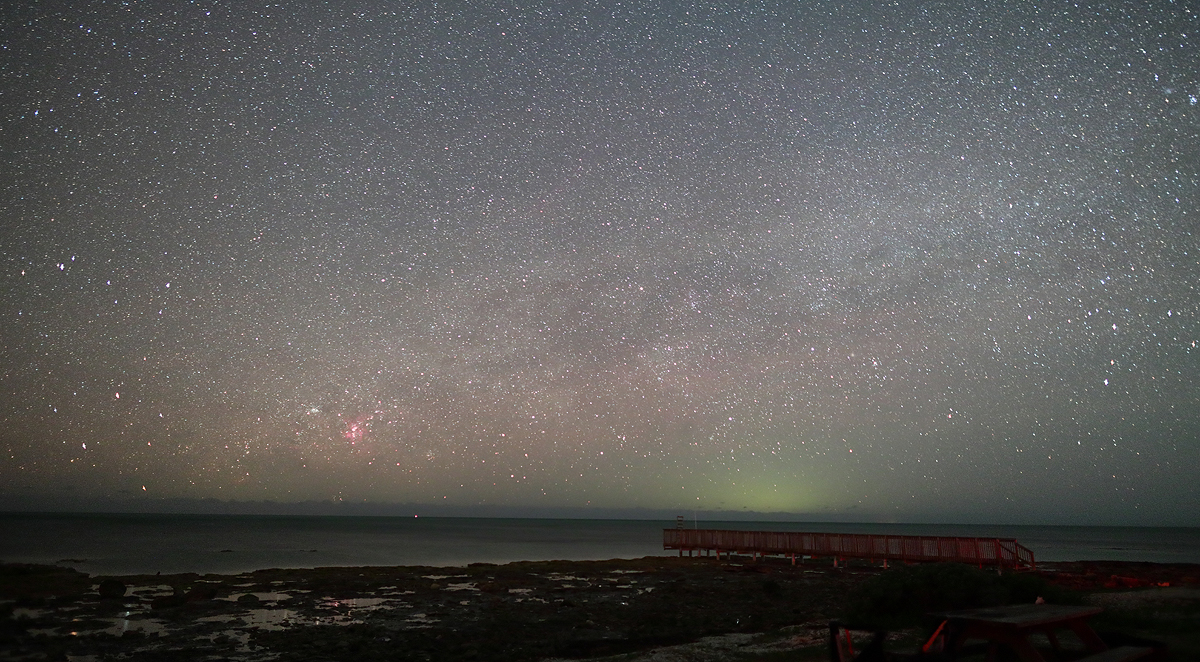 We observed with Joe's 32" f/3.6 visually, and some nebulae we could not spot in Orion with the 12.5" NVT were also barely there in Joe's 32" - these were NGC 2170, 2182, 2183, 2185. We could detect a little bit of a glow, but not much. The Ghost of Jupiter (NGC 2342) looked a lot like the Eskimo on this night, and was a beautiful green. NGC 2440 was a small planetary, elongated with some diffuse detail around it. NGC 2371 was nice, with the two lobes easily visible and the fainter outer lobes showing perpendicular to the main brighter lobes, a very interesting object to revisit. NGC 2207 is really two interacting galaxies, but due to a lack of communication and sleep, I thought it was a planetary nebula! M46 and Thor's Helmet, WSP staples, were good but not as detailed as other nights. Hubble's Variable Nebula is always a treat at high power. We had intended to view NGC 2579 in the nightvision scope, but it was small and the 32" showed it well visually. The Spindle Galaxy was a nice view, but the seeing was not superb. We viewed the Eskimo at ~800x, and again it was nice but not as detailed as in other years. M87 did not show its jet like it does in the 32" under good WSP seeing. As we were viewing M87, clouds began to come in from the northeast with the now changed wind. The sky degraded rapidly, and we headed back to our camp area to sip a beer and wait for a launch by SpaceX that was scheduled for 1:30am. At about 1:39am, I spotted the second stage over the trees just separating from the first, and the first stage shut down or its engines turned away from us. The delicate plume of gas was visible in motion as the second stage rose and then went out of sight. I had never seen a plume like that, so large and so delicate and almost impossible to capture with a camera. It was a great way to end the night. Thursday was warmer and sunny, with some clouds. I reviewed and worked on my talk, and Mario departed around lunch time to go back to the frozen northeast. I gave my talk at 2pm. This talk was about thermal issues with mirrors and telescopes, and it contained videos of Schlieren tests of various types of fan setups. The power went out while I was speaking, but someone had a backup for the TV display, which was far superior to a projector in the open-air setting under the showers and bathrooms. There was a good crowd with good questions, and the talk was well received. Thanks to Kara for the photo below. 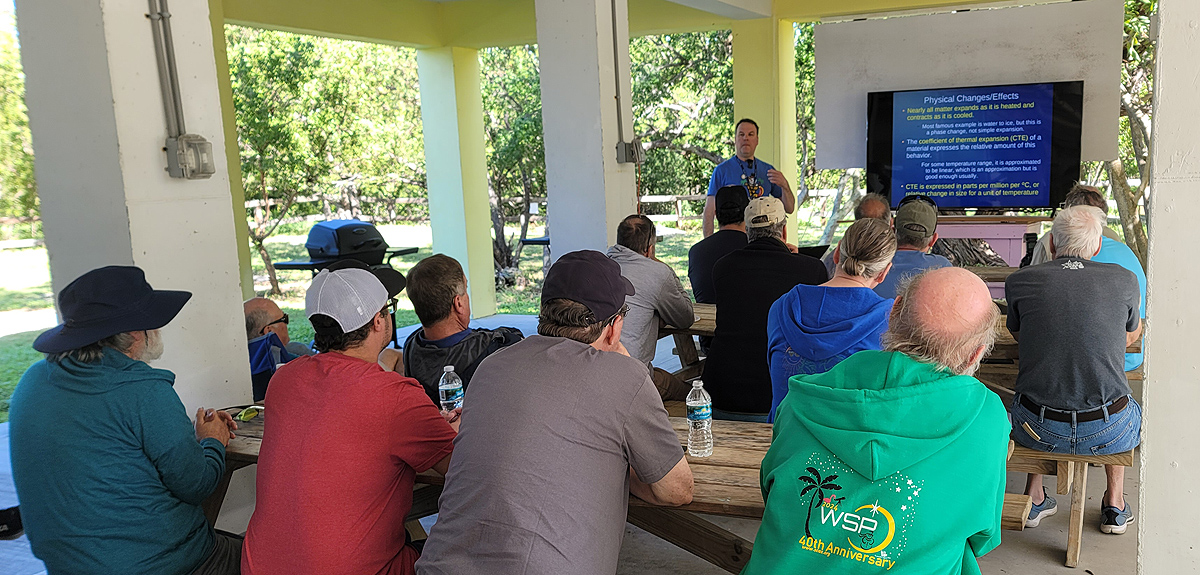 After the talk we headed back to Marathon for another dinner at Keys Fisheries. Kara has Mahi tacos, I had lobster bites and coconut shrimp. It was all absolutely delicious, and I wish I did not live so far away from this great food. This was an outstanding dinner, and it was our clear favorite for the cost and setting. Back at the camp, we took sunset photos, clouds came in for a while, but they soon cleared. 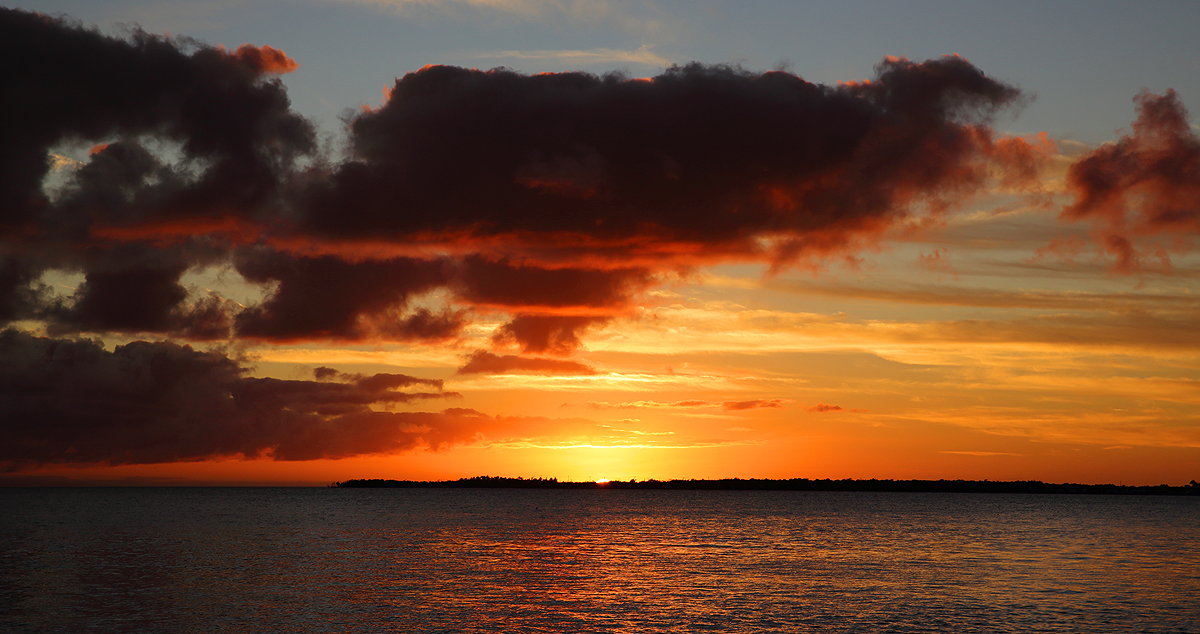 I showed objects to the people staying in the next tent for a bit, then it clouded up again and sprinkled briefly, but then cleared again. This is not uncommon for the Keys, you just have to roll with it and cover your scope if you suspect rain. I observed many objects, and even caught some galaxies. Kara was elsewhere, but left her camera shooting a time lapse of my scope, the ocean, and the southern sky. 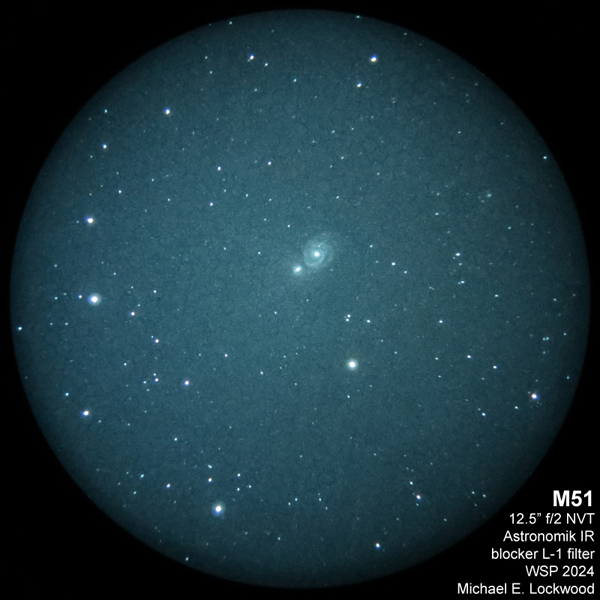 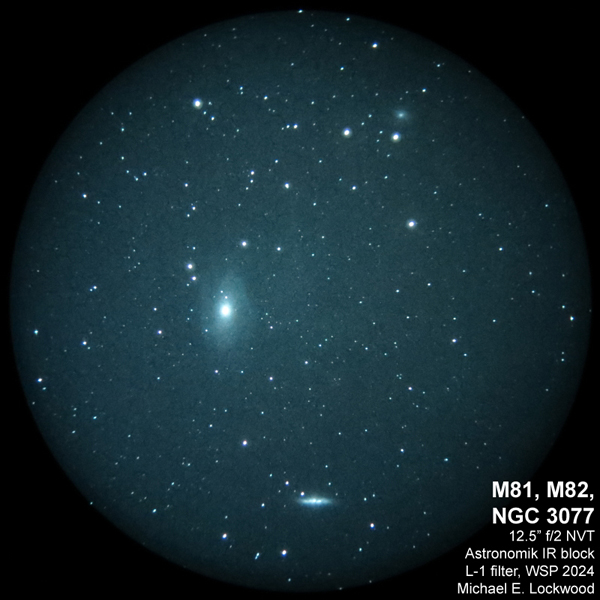 I believe Kara was doing visual observing with Harry while I entertained myself and a few passers-by. I wandered down toward Harry's observing location and stopped to talk to Jon Talbot, who made an offer I couldn't refuse - Key Lime Pie! We chatted as I ate. I look forward to seeing Jon and Dean again at Okie-Tex. We didn't stay up too late, and got up at a reasonable hour to pack up the car before the door prize drawing. Packing went quickly with Kara's expert help, and we went over to the Girl Scout camp for perhaps the longest door price drawing that I have seen at WSP. There were over 70 items, but despite the odds being in our favor, we did not win anything. There was a presentation for Mickey's Kitchen, the food truck that has served the star party for decades. This was their last star party, and I realized afterward that I should have taken more photos of them and the camp in general for this article. We said some goodbyes and left camp about 1pm. Traffic was a bit slow but moving along, and we did end up hitting some slow spots north of Miami, but overall the trip back north on a Friday afternoon was less trouble than I expected. Margaritas were enjoyed around a campfire of mostly pine cones at my uncle's house as we looked up at the partly cloudy sky and contemplated a great week in the Keys. Heading Home Kara left on Sunday, and I stayed at my uncle's and we enjoyed the Super Bowl and some good food. The next morning I was up early to pack and start heading north. My first day's drive went up I-95 to Jacksonville, making a stop to pick up a bit more rum for friends, and then west across I-10 and north to Montgomery, Alabama to visit a client for dinner. As it turned out, there was a great little restaurant/grocery nearby with a great beer selection, so the next morning I was able to add a few things I had not found at the usual spots in Florida. Then it was on to just north of Birmingham that afternoon to drop off rum and pick up beer, and then home on Thursday afternoon. Overall it was a fantastic trip thanks to Kara, my relatives, friends in Chiefland and Alabama, and a superb WSP put on by the dedicated staff there and volunteers from SCAS. I hope I see you there in upcoming years. |
Clear, dark, southern skies, good seeing, and cheers. See you at WSP 2025. -Mike Lockwood, Lockwood Custom Optics |